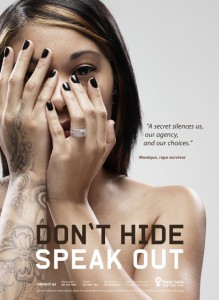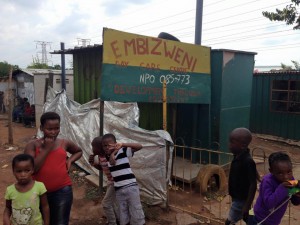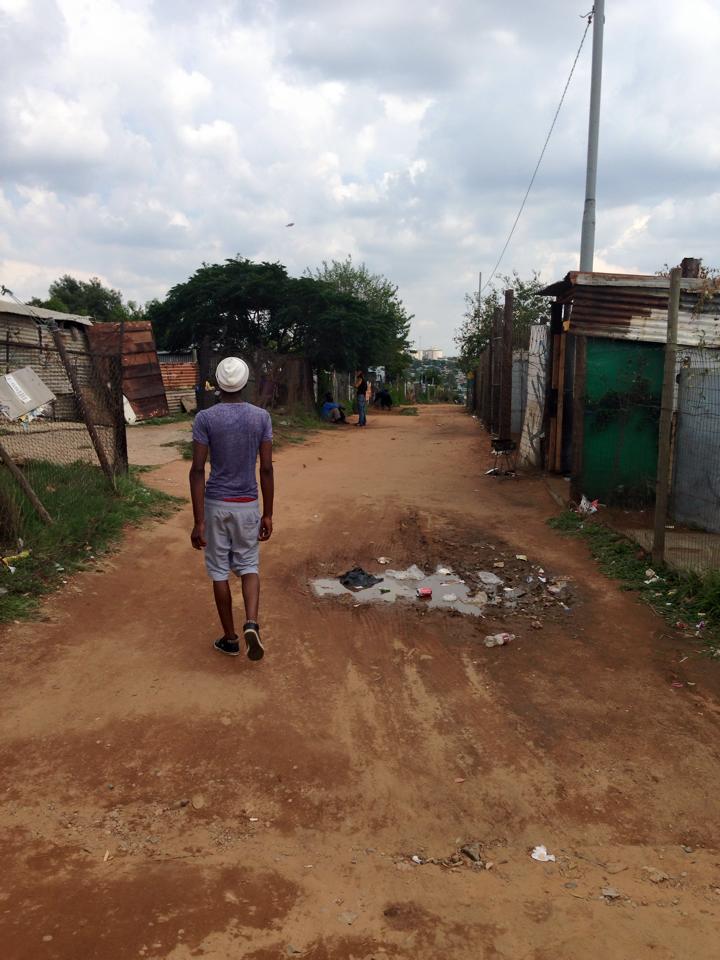By Mariel Turner
Charlene Smith was enjoying a typical night at home, nearly 17 years ago, when one stranger changed her life forever.
“On April 1, 1999 I was raped in my home by a knife-wielding man.”
Smith, a journalist from Johannesburg, said the rape and stabbing attack left her traumatized, fearful and suddenly aware of the horrors South African women face every day.
“I needed drugs to sleep and tranquilizers for those times when I became fearful or tearful,” wrote Smith in an article in the Mail and Guardian.
“The rates in South Africa are so significant. There is so much rape. The figures show the incident of rape is declining, and that’s not true. What’s happening is that women are giving up on talking,” Smith said during a Skype interview last month.

Women’s groups in South Africa estimate that a woman is raped every 26 seconds and over 40 percent of South African women will be raped in their lifetime, according to human-rights organizations.
“What you’ll find in South Africa is that rape is very violent,” Smith said. “Women go to the police stations to try and report and they’re often laughed at. There have been instances of women being raped by the officers they’re trying to report to. So women are just really giving up.”
Sarah McLaughlin, a communications coordinator at Rape Crisis Cape Town Trust, has been working with rape and sexual assault survivors for decades. The epidemic of rape in South Africa is damaging the country in profound and, possibly permanent ways, according to McLaughlin.
“Sexual violence places a massive burden on our economy,” McLaughlin said. “The effects of rape are so devastating, and the high number of women who are raped in South Africa means that a large portion of our population is dealing with psychological trauma, physical illness, substance abuse – which often means they are unable to work, or even provide proper care for their children. Rape erodes the social fabric of our communities.”
Paula Fray, the first female news editor of The Star newspaper in South Africa, said that there is an air of indifference when covering or discussing the high rates of rape.
“One of the big issues about South Africa is that, because gender based violence is so pervasive, very often it doesn’t make the news unless it is very dramatic. Unless the woman is gang raped, or the woman is raped and assaulted and mutilated. What we’ve done is, we’ve normalized rape,” Fray said.

Scholars suggest that a host of factors contribute to the high instances of rape in South Africa. Some of those factors include poverty, lack of education and substance abuse. However, one of the most pressing is patriarchal traditions. A culture influenced by misogyny and lack of opportunity for women is one of the biggest motivators for rape, according to McLaughlin.
“The prevailing patriarchal ideologies that exist in South Africa that maintain the oppression of women and give rape and ownership of women’s bodies legitimacy,” McLaughlin said. “Many of South Africa’s traditional practices contribute to this, for example the Xhosa tradition of paying ‘lebola’ for a wife, and indeed you will hear men say that they are entitled to sex from their wife because they have paid for and own them.”
Lebola is the equivalent to a bride price or dowery. In traditional South African culture, the men of both families meet to determine an appropriate price that the groom must pay for his bride. The payment is often cattle or livestock.
McLaughlin was careful to point out that it’s not only traditional or native cultural practices that can influence the high rates of rape in South Africa. The conservative nature of the Afrikaans culture can have an impact as well.
“The Afrikaans culture is also very conservative and people believe that a woman’s place is in the home with the children, and that men are strong and the leaders in the household,” McLaughlin said.


This tendency towards patriarchy has also been noted in South African media as well. When asked what factor may play the biggest role in high instances of rapes, Jillian Green a South African journalist who works for The Times, agreed that patriarchy was to blame.
“South Africa is still very much a patriarchal society where men believe they are superior to women who they believe are there to serve them,” Green said. “In all the African cultures, be it Zulu, Xhosa, Sotho etc., women are encouraged to be subservient to men. Bow to them, feed them first. Women demanding to be treated as equal is challenging the status quo and some would argue be the cause of gender based violence.”
Fray agreed with Green’s sentiments. Due to cultural customs, women in South Africa lack the confidence to fight back.
“From a cultural point of view there are some really embedded practices and beliefs around a woman’s role that often just make it difficult for us to be able to move on from where we are,” Fray said.
“If you’re a woman very often you wouldn’t feel like you have the agency to stand up against the person. You’re looking at economic issues, you’re looking at social issues, and you’re looking at pervasive roles and expectations of women’s place in society. Women don’t feel like they can stand up and make demands about how they’re treated.”
Entrenched poverty can also lead to high rates of rape in South Africa. Forty-five percent of the population is at or below the poverty line, according to the World Bank. Pervasive poverty can put many women in dangerous or desperate situations.
“Even after 20 years of democracy, we still live with massive inequality and the poor have inadequate housing,” McLaughlin said. “Sometimes many living in the same room and witnessing sexual acts, there’s inadequate access to services and information, high rates of substance abuse, and lack of access to justice.”
Fray elaborated on the economic disparities between middle and upper middle class women and underprivileged women. Living in many of the poorer, urban townships leaves women vulnerable to attack, according to Fray.
“The things you and I take for granted. Living in a house where you can lock the door, safety around were you’re living doesn’t necessarily exist there,” Fray said.
“If you’re living in settlements chances are you’re using a toilet that is not inside. You’re having to walk a few 100 meters in the dark to go to the toilet. Commuting to work in the dark. Even taking something like a taxi, and being the last woman on the taxi. It can be a very dangerous situation. Very often women are the most vulnerable in those situations. Some of them are practical and some of them are attitudinal.”
For the women who are raped and/or attacked and have the strength to be vocal about their experience, many are faced with another significant hurdle: reporting and conviction. Due to the stigma of rape in South Africa, many survivors feel they have nowhere to turn.
“What you’ll find in South Africa is, we very openly talk about sex and sexuality,” Smith said. “When you’re open about sex and sexuality you should get a greater increase in reporting, but only if the rape victims are being supported by the medical and criminal justice system.”
Many women face barriers when they report rape and sexual violence in local South African police stations. A recent report from the Johannesburg-based Institute for Race Relations, found that more than 1,400 serving police officers, or about one in 100, have a criminal record for serious, violent offenses. Many of these offenses are rape.
“Within the implementation what you have is, you have gender norms within the police station. A woman will come into the station to lay a charge against her partner, whether it be marital rape, or date rape. And the police are like ‘what do you mean your husband raped you? That can’t exist’,” Fray said.
“It’s going to take a lot of campaigning, a lot of education for people to be able to recognize that a woman can, in fact, can say no, even to her husband.”
Only one in nine rapes are reported and of those reported only 14 percent of perpetrators of rape are convicted, according to scholarly journal The Lancet.
“The criminal justice system has potential for causing secondary trauma to the survivor – CJS personnel are sometimes insensitive and judgmental, and do not inform the survivor of her rights and her options. Court cases often take over a year to go to trial, and of the fraction that make it to court, only a few end in conviction. This is a huge hurdle in the recovery of a survivor who deserves justice and closure,” McLaughlin said.

Recalling on her own experience, Smith said that while medically things have improved, legally they have not. More and more women are talking with their doctors, but not with legal authorities.
“In South Africa, medically you’ve got men or women or children who report. And that’s really become advanced since I was raped. However, the criminal justice system is better in the U.S. than in South Africa in terms of protecting people,” Smith said.
One of the large issues surrounding sexual violence when Smith was raped in 1999 was HIV and STD risks from rape. Even with the growing availability of antiretroviral drugs and antibiotics, health risks continue to be a problem today. There are 6.1 million people living with HIV in South Africa and young women aged 15-24 are four times more likely than men of the same age range to contract the virus, according to the Human Sciences Research Council. Gender-based violence has been listed as one of the primary reasons for this disparity.
“Women are also more likely to contract HIV or other sexually transmitted infections through rape because of the violence inherent in the act and the tears in the skin that often occur,” McLaughlin said. “Because rape drives HIV infections, it places a burden on our services. These services are not sufficient and the burden falls mainly on NGOs and CBOs to fill the gaps where the state is inadequate. Furthermore, the South African government does not prioritise the issue of gender violence, meaning that insufficient funding is allocated to those providing these services.”
National programs and intiatives have been faciliated through the South African government and health ministry, such as the Thuthuzelas Centers and the Sexual Offenses Bill. Anti-rape campaigns have also been intiated throughout the country. Yet, Fray wonders, “Why after all of the campaigns, after all of the outrage, after all of the programs that we put in place, it still persists.”
Through her work at Rape Crisis, McLaughlin and her staff seem to have the answer. The key to tackling and controlling sexual violence in South Africa is through grass roots efforts, specifically ones that target the young.
“We work with youth in schools, both male and female, in order to challenge the prevailing attitudes toward women and toward rape,” McLaughlin said. “This has been very effective for us and we have seen an amazing shift in the attitudes of the youth that we work with. The true impact of our work with these youth will unfortunately only show itself many years down the road, as these social norms filter to their families, to their peers, into their communities, and one day to their own children.”

Smith said she knows firsthand the power of community in helping survivors.
“It’s very important to speak to other people who have been raped. You can get more empathy from them,” Smith said. “Rape will not end until rape survivors speak out about the fact that they were raped.”
And while rape is traumatizing, terrifying and damaging, overcoming and conquering this experience can also be a source of power for women, not only in South Africa, but worldwide, according to McLaughlin.
“What stands our most for us, is the power of women that emerges through our engagement with them,” McLaughlin said. “Women are incredibly strong, and are able to not only recover from a trauma like rape, but grow stronger still, in the face of their own trauma and the multitude of other injustices they face on a daily basis.”


